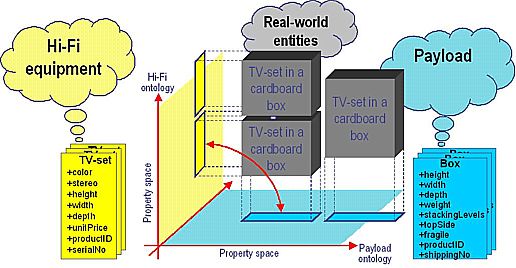
The Semantic Translation ontology tries to capture the knowledge in the area of discovering and describing conceptual correspondence. The picture below gives an example of practical problems of concept reclassification between different ontologies:

In this example, a real-world entity - TV-set in a cardboard box - is represented very differently in two domain ontologies - the ontology of Hi-Fi equipment, and the transportation ontology. Although two representations may refer to the same real entity, in order to communicate that fact to the users of the other ontology we need to perform a semantic enrichment, in order to determine the proper classification of the concept in the other ontology.
What's even worse, we may discover (as is often the case) that the concepts overlap only partially, and the conditions under which they match the concepts from the other ontologies are defined by complex formulas, dependent potentially on several factors such as values from external resources, time, geographical region etc. In this case, the physical dimensions of the TV-set concept are confusingly homonymous to the dimension properties of the Box concept, but in the first case they refer to the TV-set chassis, and in the second case they refer to the cardboard box dimensions. Furthermore, the Box dimensions might be allowed to take only certain discrete values (e.g. according to a normalized cardboard container types), so in order to determine their values based on the information available in the TV-set concept, it is necessary to access some external resource (a cardboard box catalogue).
This work is a part of the E-Commerce Integration Meta-Framework project (see http://www.ecimf.org for more information).
This ontology has been created as a result of discussions among the ECIMF project members, and specifically: Andrzej Bialecki (WebGiro), Martin Bryan (SGML Centre), Ambjörn Naeve (KTH), Mikael Nilsson (KTH), Heiner Stuckenschmidt (Univ. of Bremen) and others. The part that is most notably missing in it is specification of the Formula language. In the course of discussions the ECIMF project members were led to believe that first-order logic is not sufficient to express the complexity of relationships occuring in this area, and a full programming language may be the best pragmatic solution (candidates include XSLT and JavaScript).
Here's the Semantic Translation ontology in a Protege project zipfile. Here's the OntoViz diagram of the main concepts. Here is also the ontology saved as an RDF schema , and the associated project zipfile.
Originally, this ontology has been developed as a UML model. Here's the main class diagram. For now, these two models - UML and Protege - are synchronized manually. I'd appreciate suggestions on how to automate that process.
For comments and further info please contact the author: Andrzej Bialecki .
Last updated: November 12, 2001.